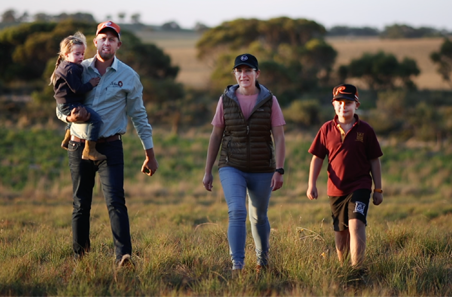Ag-tech solutions to drive productivity

The Schulz family (pictured) are implementing a range of ag-tech solutions including management software, water monitoring, electronic identification (eID) and sheep handling infrastructure at their SA farm.
The family is targeting an extensive list of improvements, including:
- improved record keeping
- increased lambing rates, lamb survival and lamb growth rates
- easier and more efficient animal handling
- enhanced water security.
'Coolaroo' is one of 13 Focus Farms identified by the South Australian Government’s Red Meat and Wool Growth Program supported by MLA, SA Sheep and Cattle Industry Funds, and SheepConnect SA. Focus Farms demonstrate the practical application of ag-tech and biosecurity best practice.
Here’s a look at the Schulzs’ seasonal strategies to address water security and reproductive efficiency through summer and into lambing.
Water security
Coolaroo uses mains water due to the high salinity levels of underground water. There are two water meter monitors, which provide daily SMS updates of minimum and maximum water use, and alerts if usage is outside threshold values to identify water supply issues.
“The great benefit of the system is in detecting excessive use and water leaks before they become costly (detecting a major leak early can pay for set-up of the system),” Jason said.
“Water monitoring also provides peace of mind in knowing water usage is in the normal range, especially when we’re away from the farm.”
The system allows the family to detect and fix minor leaks by switching off different lines over successive nights.
Reproductive gains
Penny and Jason, who have completed the Lifetime Ewe Management and Lambs Alive programs, pay particular attention to lamb survival.
They condition score ewes regularly in spring and use silage supplementation to ensure a score of 3 or higher at joining. Ewes are teased with testosterone-treated wethers for two weeks before joining, with rams introduced mid-late October for five weeks.
Ewes are pregnancy scanned for multiples 90–100 days after joining, and multiple-bearing ewes are drafted off at scanning to allow preferential nutrition to begin.
Twin-bearing ewes are run in the smallest mobs possible (70–90 ewes) on the best feed in the best lambing paddocks. Penny and Jason record lamb survival in every paddock and find twin survival can reach 90% in small mobs in the best lambing paddocks.
“The ideal lambing paddock is probably small and square with scattered single trees rather than a block of scrub or a treeline, reducing the chance of mismothering,” Jason said.
Because ewes are teased, most lambs are born within the first two to three weeks of lambing.
Livestock handling
Penny and Jason are installing new technologies to support flock management, including new sheep yards with a roof over the main work area, and a permanent six-metre ProWay bulk handler and three-way auto-drafter.
The new equipment will significantly reduce manual labour in the sheep operation and enable easier recording and more convenient weighing, animal health treatments and condition monitoring. In the beef enterprise, cattle are currently weighed in a crush, but Penny and Jason plan on installing a dedicated weigh box in front of the crush for more convenient weighing of cattle.



